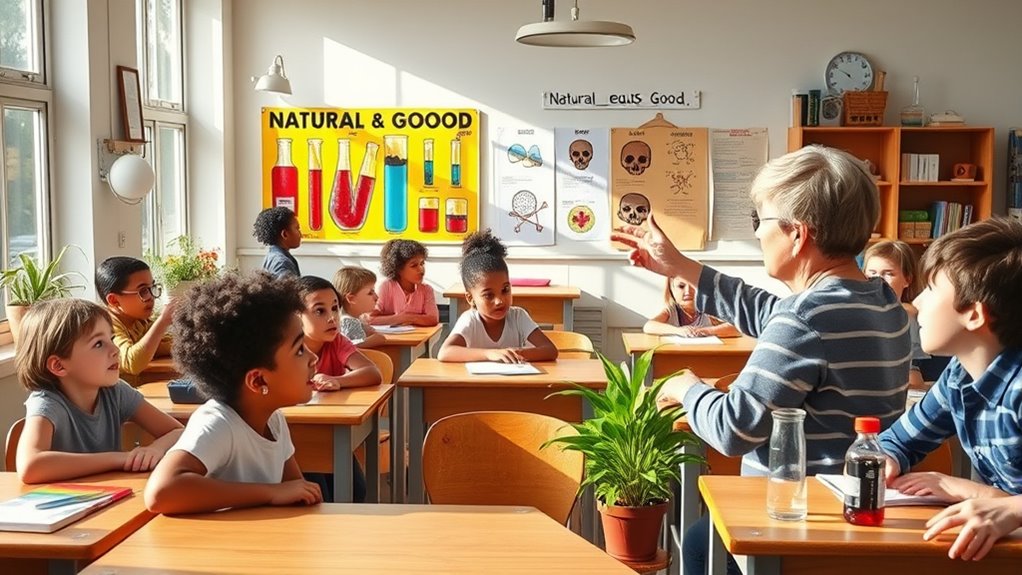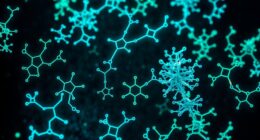Teaching that natural substances are always safe can create harmful misconceptions about chemicals and science. It leads students to believe that synthetic or man-made chemicals are automatically dangerous, which isn’t true. This oversimplification fosters fear, discourages curiosity, and impacts how they view chemistry’s role in daily life. By addressing these misconceptions and promoting a balanced perspective, you can help students develop a more accurate understanding and healthier attitude toward science. Keep exploring to learn how to effectively achieve this.
Key Takeaways
- Teaching “natural=good” fosters misconceptions that natural chemicals are inherently safe, ignoring scientific evidence of risks.
- Overemphasizing natural substances can lead to underestimating dangers of certain natural chemicals and overestimating synthetic ones.
- Such bias reinforces fear and caution, discouraging students from exploring chemistry’s true benefits and safety practices.
- It promotes a false dichotomy that hinders understanding of the complex roles chemicals play in health and the environment.
- A balanced approach that discusses both natural and synthetic chemicals with safety context is essential for accurate scientific literacy.

Chemophobia, or an irrational fear of chemicals, often takes root in the classroom, shaping students’ perceptions of science and chemistry. This fear isn’t just about avoiding certain substances; it’s about how students interpret the information they receive and what they believe to be true.
Chemophobia influences classroom perceptions, shaping how students interpret and believe about chemicals and science.
When students are exposed to messages that paint chemicals as inherently dangerous, it fosters hazardous perceptions that can persist long after they leave the classroom. These perceptions are often reinforced by media stories or misconceptions that highlight chemical risks without providing proper context. As a result, students may develop a skewed understanding of chemistry, believing that all chemicals are harmful, which isn’t accurate.
They may also think that “natural” substances are automatically safe, while synthetic or man-made chemicals are inherently toxic. Such student misconceptions can hinder their curiosity and willingness to explore science further. They might also reject scientific evidence or dismiss the benefits of chemicals in everyday life because of their ingrained fears.
When you teach with this mindset, it’s easy to inadvertently perpetuate these hazardous perceptions. You might focus too much on the dangers of chemicals without emphasizing their essential roles in medicine, agriculture, and industry. This creates a misleading dichotomy where natural equals safe and synthetic equals dangerous.
Students then start to believe that “natural” substances are always good, ignoring the fact that many natural compounds are toxic, while some synthetic chemicals are beneficial and safe when properly used. This oversimplification fosters misconceptions that can make students overly cautious or even fearful of chemistry, preventing them from engaging fully in experiments and scientific inquiry.
It’s vital to recognize that these hazardous perceptions aren’t just innocent misunderstandings—they shape how students approach science and their understanding of the world. When you fail to address these misconceptions, you risk reinforcing a negative view of chemistry as a field full of dangers rather than a discipline that enhances our lives. Additionally, understanding the role of chemicals in everyday life can help students develop a more balanced perspective and appreciation for scientific progress. Moreover, emphasizing the importance of proper safety protocols can further reduce unfounded fears and promote responsible exploration.
Instead, you should aim to provide a balanced perspective that highlights the benefits of chemicals while honestly discussing risks and safety. Doing so helps dismantle student misconceptions and encourages a more accurate, nuanced understanding of chemistry.
Frequently Asked Questions
How Can Teachers Effectively Address Students’ Misconceptions About Chemicals?
To address students’ misconceptions about chemicals, you should focus on misconception correction through clear science communication. Use relatable examples to explain that all substances, natural or synthetic, can be harmful or safe depending on their context.
Encourage questions and foster critical thinking, emphasizing evidence-based understanding. By actively engaging students and dispelling myths with factual information, you help them develop a balanced view of chemicals, reducing fear and fostering curiosity.
What Are the Long-Term Impacts of Chemophobia on Scientific Literacy?
Imagine a garden where only the flowers labeled “natural” bloom, ignoring the weeds of scientific skepticism.
Long-term, chemophobia stunts your growth in chemical literacy, making you dismiss essential compounds and overlook risks.
This mindset weakens your ability to evaluate science critically, leading to ignorance and mistrust.
Without understanding chemicals’ true nature, you risk making poor decisions, undermining progress, and losing confidence in science’s role in society.
How Does Media Influence Public Perceptions of Natural Versus Synthetic Substances?
You see media framing often emphasizing natural substances as safe while sensational headlines highlight synthetic ones as dangerous, shaping your perceptions.
This skewed coverage leads you to believe natural is always better, ignoring scientific facts.
Media influences your views by sensationalizing risks and benefits, making you more cautious or dismissive of synthetic substances.
Recognizing this bias helps you develop a more balanced understanding of natural versus synthetic, fostering informed decision-making.
Are There Specific Age Groups More Susceptible to Chemophobic Attitudes?
You might notice that children’s perceptions often lean toward labeling natural substances as safer, while teenage skepticism grows as they question claims about chemicals.
Younger kids tend to accept information at face value, making them more susceptible to chemophobic attitudes.
Conversely, teenagers are more likely to critically analyze and challenge such ideas, but still remain vulnerable to misinformation if not guided properly.
Recognizing these differences helps you tailor your education approach effectively.
What Role Do Parents Play in Shaping Attitudes Towards Chemicals in Children?
Your parent influence and family beliefs shape how children view chemicals early on. If you emphasize that natural is always better and avoid discussing the safety of synthetic chemicals, your child might develop chemophobic attitudes.
Conclusion
Imagine your classroom as a garden. If you label certain plants as dangerous without understanding them, you miss out on their potential benefits. Just like plants need careful nurturing, chemicals need informed teaching, not fear. By dismissing all “natural” things as good and all “artificial” as bad, you risk choking the garden’s growth. Embrace curiosity over fear, and you’ll help your students cultivate a balanced, thriving understanding of chemistry’s true role in the world.








